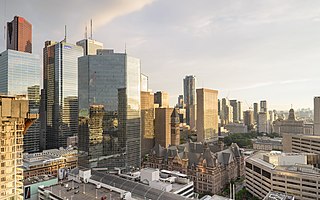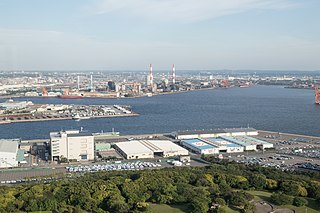
The economy of Quebec is diversified and post-industrial with an average potential for growth. It is highly integrated with the economies of the rest of Canada and the United States. Manufacturing and service sectors dominate the economy.
Hollywood North is a colloquialism used to describe film production industries and/or film locations north of its namesake, Hollywood, California. The term has been applied principally to the film industry in Canada, specifically to the cities Toronto and Vancouver.

Montreal Locomotive Works (MLW) was a Canadian railway locomotive manufacturer that existed under several names from 1883 to 1985, producing both steam and diesel locomotives. For many years it was a subsidiary of the American Locomotive Company. MLW's headquarters and manufacturing facilities were in Montreal, Quebec.

Royal Bank of Canada is a Canadian multinational financial services company and the largest bank in Canada by market capitalization. The bank serves over 20 million clients and has more than 100,000 employees worldwide. Founded in 1864 in Halifax, Nova Scotia, it maintains its corporate headquarters in Toronto and its head office in Montreal. RBC's institution number is 003. In November 2017, RBC was added to the Financial Stability Board's list of global systemically important banks.

The Montreal Exchange, formerly the Montreal Stock Exchange (MSE), is a derivatives exchange, located in Montreal, Quebec, Canada that trades futures contracts and options on equities, indices, currencies, ETFs, energy and interest rates. Since 1965, it has been located in the Tour de la Bourse, Montreal's third-tallest building. It is owned by the Toronto-based TMX Group.
Big Five is the name colloquially given to the five largest banks that dominate the banking industry of Canada: Bank of Montreal (BMO), Bank of Nova Scotia (Scotiabank), Canadian Imperial Bank of Commerce (CIBC), Royal Bank of Canada (RBC), and Toronto-Dominion Bank (TD).

Manulife Financial Corporation is a Canadian multinational insurance company and financial services provider headquartered in Toronto, Ontario. The company operates in Canada and Asia as "Manulife" and in the United States primarily through its John Hancock Financial division. As of December 2021, the company employed approximately 38,000 people and had 119,000 agents under contract, and has CA$1.4 trillion in assets under management and administration. Manulife at one point serviced over 26 million customers worldwide.

The economy of Toronto is the largest contributor to the Canadian economy, at 20% of the national GDP, and an important economic hub of the world. Toronto is a commercial, distribution, financial and industrial centre. It is Canada's banking and stock exchange centre and is the country's primary wholesale and distribution point. Ontario's wealth of raw materials and hydroelectric power have made Toronto a primary centre of industry. The metropolitan area of Greater Toronto produces more than half of Canada's manufactured goods. The economy of Toronto has had a GDP growth rate of 2.4 percent annually since 2009, outpacing the national average. Toronto's population was 3.025 million people as of 2022, while the population of the Toronto census metropolitan area was 6.47 million during the same year.

Japan's major export industries include automobiles, consumer electronics, computers, semiconductors, copper, and iron and steel. Additional key industries in Japan's economy are petrochemicals, pharmaceuticals, bioindustry, shipbuilding, aerospace, textiles, and processed foods.
The pharmaceutical industry is one of the leading industries in the People's Republic of China, covering synthetic chemicals and drugs, prepared Chinese medicines, medical devices, apparatus and instruments, hygiene materials, packing materials, and pharmaceutical machinery. China has the second-largest pharmaceutical market in the world as of 2017 which is worth US$110 billion. China accounts for 20% of the world's population but only a small fraction of the global drug market. China's changing health-care environment is designed to extend basic health insurance to a larger portion of the population and give individuals greater access to products and services. Following the period of change, the pharmaceutical industry is expected to continue its expansion.
The pharmaceutical industry in India was valued at an estimated US$42 billion in 2021 and is estimated to reach $130 billion by 2030. India is the world's largest provider of generic medicines by volume, with a 20% share of total global pharmaceutical exports. It is also the largest vaccine supplier in the world by volume, accounting for more than 60% of all vaccines manufactured in the world. Indian pharmaceutical products are exported to various regulated markets including the US, UK, European Union and Canada.

Banking in Canada is one of Canada's most important industries with several banks being among its largest and most profitable companies.
Ortho Pharmaceutical was initially formed in the United States in 1931 as a subsidiary of Johnson & Johnson to market the first prescription spermicidal contraceptive jelly, Ortho-Gynol.
Canadian science fiction television was produced by the CBC as early as the 1950s. In the 1970s, CTV produced The Starlost. In the 1980s, Canadian animation studios including Nelvana, began producing a growing proportion of the world market in animation.

The economy of Ontario is diversified. Ontario is the largest economy in Canada, making up around 38% of Canadian GDP. Though manufacturing plays an important role in Ontario's economy responsible for 12.6% of Ontario's GDP, the service sector makes up the bulk, 77.9%, of the economy. Ontario's net debt-to-GDP ratio will rise to 40.7% in the year 2019–2020.

Montreal's economy is the second largest of all cities in Canada and the first in Quebec. Montreal is a centre of commerce, industry, technology, culture, finance, and world affairs. In 2022, Metropolitan Montreal was responsible for $233 Billion CDN of Quebec's $425 Billion CDN GDP, with a population of 4.37 million people. Montreal's economy, therefore, comprises approximately 54.8% of Quebec's overall GDP.

The pharmaceutical industry in Switzerland directly and indirectly employs about 135,000 people. It contributes 5.7% of the gross domestic product of Switzerland and 30% of the country's exports. In 2017 about 30% of Swiss exports were chemical products. In the same year Switzerland was the second largest exporter of packaged medicine in the world, with about 11% of the global total, worth $36.5 billion.
Knight Therapeutics Inc. is a Canadian public specialty pharmaceutical company based in Montreal, Quebec that focuses on acquiring or in-licensing innovative pharmaceutical products for the Canadian and select international markets. It is listed on the Toronto Stock Exchange, with a market capitalization of $1.02 billion as of August 2019.

Barkat Pharmaceutical Group is an Iranian Pharmaceutical public company, which was founded in 2010, named Tadbir innovation pharmaceutical company. The company provides services through cooperation between science-based institutions and scientists based on medicine around the world. It supplies 14 percent of all the country's essential drugs through its 25 subsidiaries. The company produces 700 kinds of products in the pharmaceutical sector and offers it internally.











